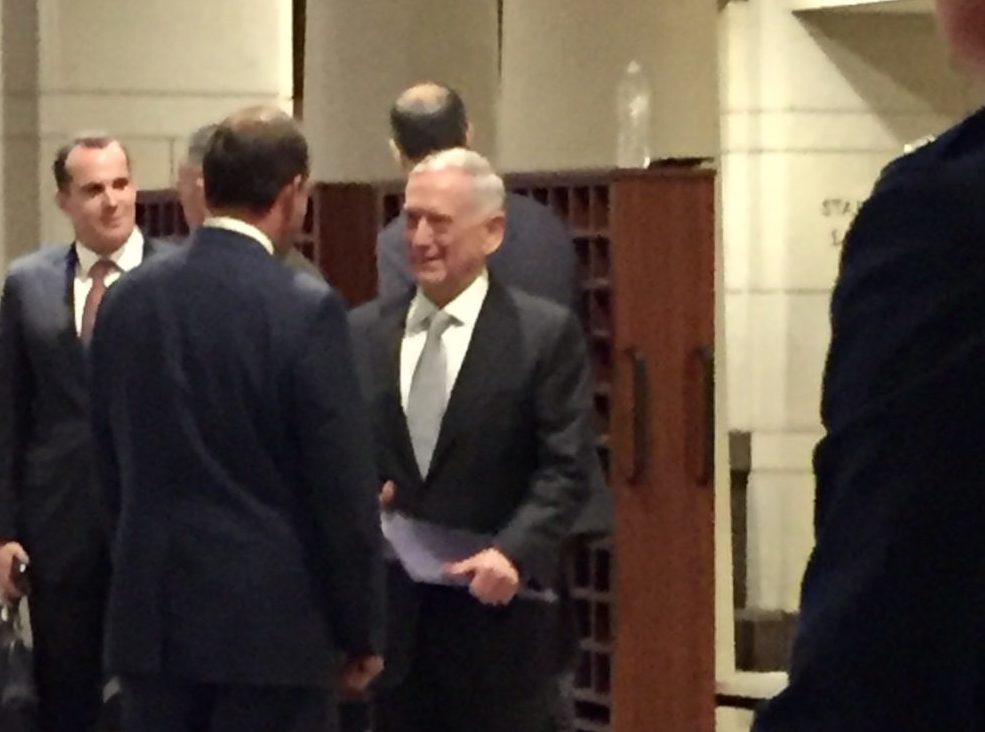Thursday, July 20th 2017 (WASHINGTON) — Top officials from the Trump administration were on Capitol Hill on Thursday to convey a strong message that the United States and it’s allies are making progress in the fight against the Islamic State in Iraq and Syria, but additional challenges still lay ahead.
Secretary of Defense James Mattis’ message about the state of play against ISIS was clear and concise.
“We’re winning. They’re losing,” the secretary told reporters as he left the classified briefing.
Mattis was on the Hill for the second time this week along with Chairman of the Joint Chiefs of Staff Gen. Joseph Dunford, Secretary of State Rex Tillerson and Brett McGurk, the top U.S. envoy to the global anti-ISIS coalition.
Gen. Dunford said he was optimistic about the progress being made on the ground, comparing the current state of affairs to the dire conditions in late 2013 and 2014 when ISIS began capturing large swaths of Iraq and Syria.
“If you look at where we were 24 months ago, you can look at the territory that they held, you can look at the resources that they had available, you could look at the potential for them to conduct external operations, and in all those areas we’ve made great progress,” Dunford told Sinclair Broadcast Group.
In just the past month, Iraqi President Haider al-Abadi was able to declare victory over ISIS in Mosul. In Syria, U.S.-backed forces have effectively surrounded ISIS’s self-declared capital of Raqqa.
When ISIS what at it’s strongest, they controlled approximately 40 percent of the country’s territory, they are now limited to small portions of territory around Mosul and in the Anbar Province bordering Syria.
ISIS’s primary sources of revenue have also dried up. Defense analysts at IHS Markit estimate that the terrorist group has lost 80 percent of its funds since 2015.
Asked about the biggest challenges the U.S. military is now facing, Dunford said, “Mosul.”
“[The] stabilization phase in Mosul, consolidation, making sure we get effective governance and law enforcement there which the State Department is working on.”
Additionally, there are still concentrations of ISIS fighters inside Iraq, in the Hawija area in central Iraq and the Anbar Province.
In Syria, Gen. Dunford pointed to obstacles in the Euphrates River Valley, adding there are “obviously enemies south of Raqqa.”
So far, Dunford is confident that President Trump and the Congress are providing the U.S. military with what it needs to conduct its operations against ISIS.
The Department of Defense is expected to see as much as a 10 percent increase in its budget this year, and Trump has given Secretary Mattis greater authority to determine U.S. troop levels in conflict areas.
Additional U.S. troops have been sent to Syria since Trump took office, but under the president’s direction the exact number is not publicly available.
Special Envoy McGurk, who was originally appointed by President Obama to serve as the State Department’s point-man for the 73-nation anti-ISIS coalition, took note of the progress, but was cautious not to understate the challenges that remain in both Iraq and Syria.
“We’re making progress, but we’ve got a long way to go,” McGurk told Sinclair. He added that there are “no timelines” for ultimately defeating ISIS. “We don’t have any timelines on anything.”
The purpose of the officials’ meetings on Capitol Hill were ostensibly to brief members of Congress on the administration’s strategy for defeating ISIS.
Immediately after taking office in January, President Trump ordered the Pentagon to conduct a 30-day review of the counter-ISIS strategy and lay out a preliminary plan to beat the terrorist group.
By February, Secretary of Defense James Mattis had delivered an outline to the president, but it remains classified.
Members of Congress would not discuss the details of the meeting or what they learned about the administration’s approach, but Trump supporters and critics reported that they were “impressed” with the president’s national security team.
“I was very impressed,” Sen. Joe Manchin (D-W.Va.) said of the briefing with Trump officials. The administration is forging a clear plan for the defeat of ISIS, Manchin continued, and Secretary Mattis “is willing to be very aggressive in the plan.”
Sen. Thom Tillis (R-N.C.) and member of the Armed Services Committee said he was “encouraged” by the progress that has been made in recent months under the Trump administration’s leadership, but he has concerns about how it will handle the broader regional challenges.
“A lot of our progress is going to be dependent upon deconflicting with Russia and Iran’s continued agitation,” he said. “Those are variables that we just have to be able to react to.”
According to senators and congressmen who attended the briefings, the Trump officials did address concerns about the role of Russia, Iran and the Syrian government of Bashar Assad.
Currently, Russia, Syria and Iranian proxies have shored up large parts of western Syria and are moving east towards positions held by U.S.-backed Syrian Democratic Forces are positioned.
In June, there were at least three incidents of U.S. forces striking Iranian-backed militia forces who amassed outside of U.S. training camps in Syria.
“We’re right on top of each other right now,” Sen. Chris Murphy (D-Conn.) said. “I still remain very worried that as we put more and more U.S. troops inside Syria, it’s more likely that there’s going to be a major confrontation confrontation between the US and Iranian-backed forces, and I’m not sure that this president is ready for that kind of crisis moment.”
After this week’s briefings, members of Congress were still not clear as to when the administration is going to make its strategy public. Even after securing the territory taken back from ISIS, there will still be security, humanitarian and other unforeseen challenges.
In its official terrorism report, released earlier this week, the State Department assessed that ISIS, despite suffering major losses, remains “the most potent terrorist threat to global security.”
The group has been scaled by immensely, but ISIS still maintains a fighting force of approximately 12,000 to 15,000 fighters. The group has eight recognized branches, numerous undeclared networks operating worldwide and the ability to inspire homegrown extremists.






